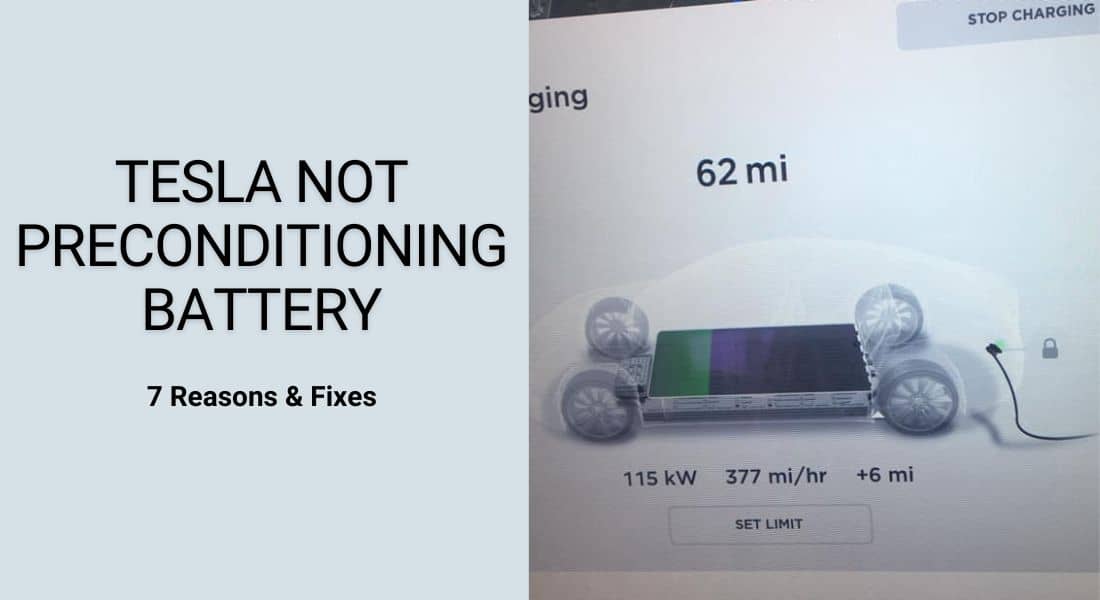Preconditioning means heating the battery to the right temperature of 40°C (104°F) for charging. Tesla has an automatic preconditioning system. Its battery automatically heats up when you’re heading to a supercharger. But this doesn’t happen every time, which means an issue here.
So, why is Tesla not preconditioning battery automatically? Generally, there are some issues that are the main culprits behind this problem, like:
- High battery temperature
- Wrong settings
- Outdated software
- Battery degradation
- Low battery
- Weather conditions, etc.
However, why do you need to precondition your Tesla battery? What will happen if you don’t? We’ll answer all of your questions about Tesla preconditioning. Let’s get started.
Tesla Is Not Preconditioning the Battery: A Quick Look at Reasons and Solutions
Before getting into the reasons in detail, here is a quick overview of them with their quick solutions.
| Reason | Solution |
| High Battery Temperature | Wait until the battery temp raise |
| Outdated Software | Update the software |
| Wrong Preconditioning and Charge Limit Setting | Change the preconditioning and charge limit settings |
| Low Battery: Less than 20% Remaining | Charge your car battery above 20% |
| Battery Degradation | Replace the battery |
| You’re too Far from the Closest Supercharger | Use Tesla’s navigation system |
Tesla Is Not Preconditioning the Battery: Reason and Solution

Now that you have a brief idea about the problems and solutions. Let’s go for an in-depth discussion so that you know what to do.
1. High Battery Temperature
If your Tesla isn’t preconditioning the battery, it might be due to a high battery temperature. Preconditioning is typically necessary when the battery’s temperature is lower than the optimal range of 40°C (104°F).
The touchscreen usually shows that the battery temperature is too high. Also, the high battery temperature automatically slows down the charging speed, and the bottom of the trunk or the back seat feels warm to the touch.
Solution
Wait for a little until the battery temperature reaches the desired level before you receive the preconditioning message. This ensures your battery is in the right condition for efficient and safe fast charging.
2. Outdated Software
Tesla regularly releases over-the-air (OTA) software updates to improve vehicle functionality. The vehicle’s software controls battery precondition.
If your Tesla’s software is outdated, it may not have the latest features and optimizations for battery preconditioning.
Solution
Check and update the latest version of the software or reset the car. To reset your car, follow the following steps.
- Go to the Control Menu and select Safety.
- Then click on the Power Off option and wait for 2 min.
To update your software,
- Press on the Control Menu.
- You’ll see an orange clock icon in the control menu. Click on it and select Update Now. But if it’s stuck in a loop, read our guide to know the causes and effective solutions for Tesla software update stuck.
3. Wrong Preconditioning and Charge Limit Setting
The charge limit of an EV determines the amount of energy the car’s battery will store when connected to a charger.
The settings decide when the car begins to warm up its cabin and battery before your scheduled departure time. So, the wrong setting may cause problems.
To precondition your Tesla battery properly, read our guide on how to precondition a Tesla battery. You will also learn about the advantages and disadvantages in this guide.
Solution
You need to change the settings. You need to change the settings. For daily driving, a charge limit of 80-90% is recommended to preserve battery health and reduce the risk of overheating.
And precondition the battery for at least 30 minutes in winter and 20 minutes in hot weather for optimal temperature. This will help your car use less energy and get more space to warm up.
4. Low Battery: Less than 20% Remaining
When your Tesla’s battery level drops below 20%, preconditioning won’t work. This is a safety measure to prevent the car from running out of power.
Solution
To enable preconditioning, you’ll need to charge your car’s battery to a level above 20%. You can do this by plugging it into a Tesla Supercharger or using a standard home charging outlet.
5. Battery Degradation
Battery degradation can significantly affect a Tesla’s ability to precondition. It reduces the overall capacity and efficiency of the battery over time.
Degraded batteries struggle to maintain optimal temperatures, impacting their performance during preconditioning. Not only that, you may also face increased battery temperature, low charging speed, buzzing noise, etc., as a symptom of a degraded battery.
Solution
As there are multiple batteries in your Tesla, you need some specialized tools to identify the defective battery, like —
- Battery impedance tester
- Cell voltage tester
- BMS data analysis tool and more.
However, if you hear any buzzing noise, find out which battery is making it, as that battery is a degraded battery and needs replacement.
The best way to fix this issue is to consider scheduling regular maintenance with Tesla service centers to monitor battery health.
6. Weather Conditions
Preconditioning of a Tesla battery doesn’t occur in extremely hot environments. High temperatures can adversely affect the battery. That’s why Tesla’s charging system chooses not to precondition to prevent further stress on the battery.
Solution
To fix this issue, consider parking your Tesla in a shaded area or a garage to reduce the impact of extreme heat. Using Tesla’s mobile app, you can manually precondition the battery before you start your journey.
7. You’re too Far from the Closest Supercharger
Tesla’s battery system begins the preconditioning process when you’re within the short range of the next Supercharger station. When your Tesla is too far from the next Supercharger station, the battery may not be a precondition.
Solution
Consider planning your trips to ensure you’re within a reasonable distance from Superchargers. You can use Tesla’s navigation system to locate Superchargers along your route, and plan stops accordingly.
What Happens If You Don’t Precondition The Battery?
Proper preconditioning helps maintain battery health and ensures it operates at peak efficiency. When you don’t precondition your battery, it may not be at an optimal temperature for efficient operation.
As a result, the battery might need to divert some of its energy to warm itself up. Skipping this step can result in decreased energy efficiency, slower charging rates, and increased wear and tear on the battery.
Over time, this can lead to a shorter overall battery lifespan and a decrease in its ability to hold a charge.
FAQs
Here, we’ve discussed a few more commonly asked questions by people using Tesla.
You can manually precondition your Tesla battery. First, you need to plug it into a charger. Next, open your Tesla app and select the Climate option. Then, set the cabin temperature.
Preconditioning a Tesla battery in summer is not essential. However, it can enhance range and comfort. It optimizes the battery’s temperature, making it work efficiently and improving your driving experience.
Scheduled preconditioning is setting a specific time for your car to prepare itself before a trip automatically. This feature optimizes battery efficiency and ensures a comfortable driving experience.
Conclusion
If you’re experiencing issues with your Tesla not preconditioning the battery, it’s essential to address the problem promptly. Preconditioning the battery is crucial for maintaining its health and range, especially in extreme weather conditions.
To resolve this issue, you can follow the steps mentioned in this guide, including checking your settings and battery temperature. Additionally, keep your Tesla software up-to-date and consult with Tesla customer support if the problem persists.
Remember that regular maintenance and attention to your Tesla’s battery health are essential for a smooth driving experience. By taking the necessary steps, you can enjoy the full benefits of owning a Tesla electric car.

I am an experienced guide in electric mobility, offering clear and expert guidance for those venturing into the world of electric vehicles.
Through collaborations, research, and hands-on experience, I navigate readers through the evolving landscape of smart automobile technologies and the significance of renewables.

